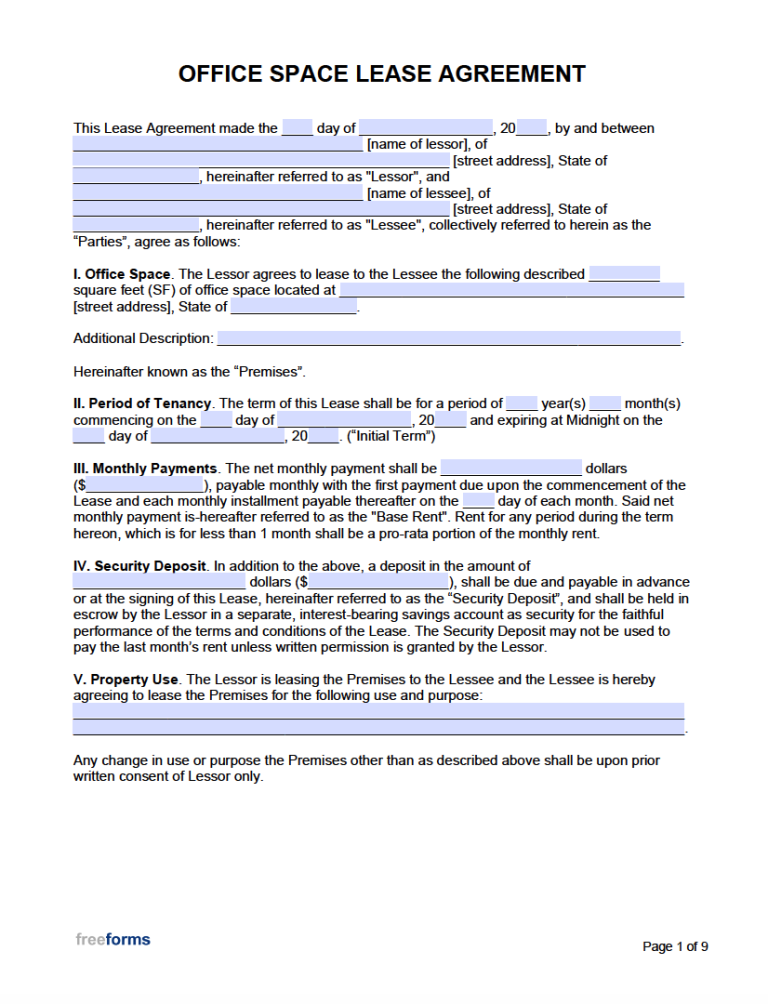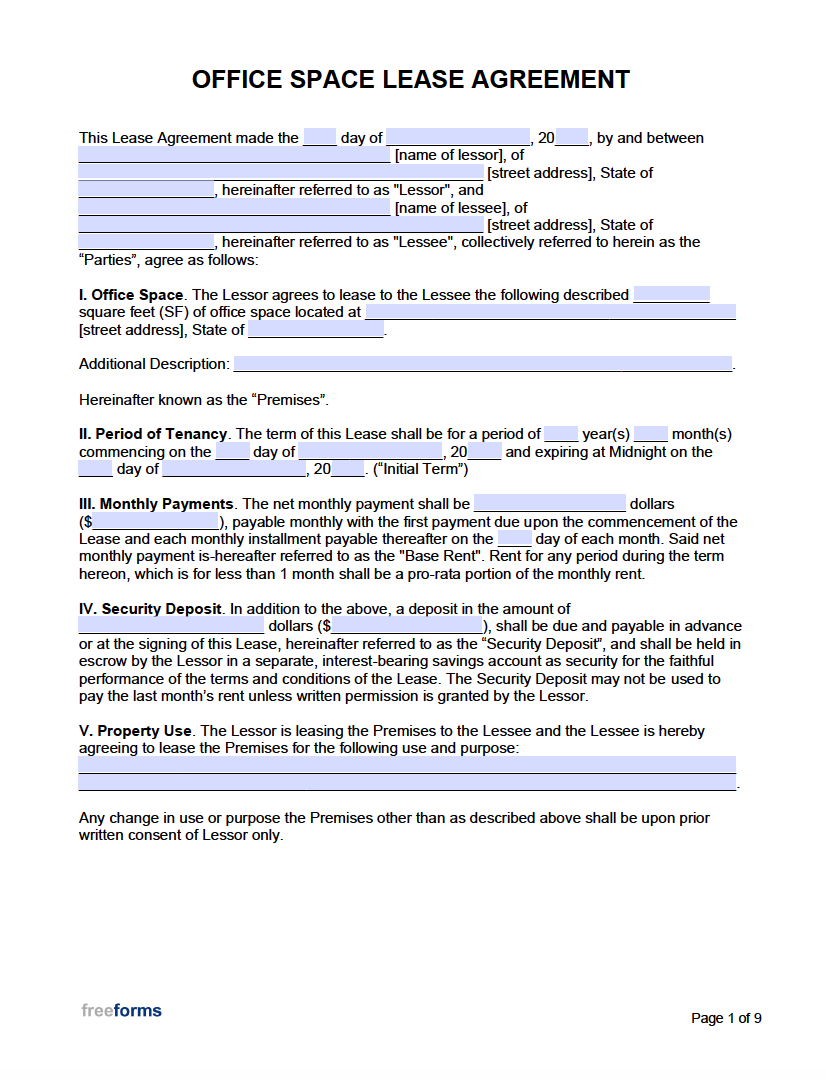Unlike a standard commercial lease that can be geared toward retail accommodation, commercial office units are not to be utilized to perform services or sell products. The downloadable form solidifies the understanding to rent between tenant and landlord, mapping out a summary of granted rights and responsibilities. The commitment is then entered into upon finalization and endorsement.
Commercial Rental Application – When leasing property for office operation, it is expected as a precautionary measure first to receive information on the prospective lessee. The prerequisite facts are obtained with the provided questionnaire to determine eligibility for rental.
How to Rent Office Space
Leasing office space will require both a lessor and lessee to do their due diligence to achieve security with the arrangement. For both parties, there are necessary steps to teak to accomplish the desired outcome of finding the right space or right tenant. Browse the following steps to be prepared when leasing an office for both the landlord or tenant.
Step 1 – Evaluating the Space / Listing Necessary Office Features
The initial priority of an owner or current tenant of a commercial office unit is to determine precisely where space stands. Establishing the actual square footage and what amenities and expenses are to be covered in the lease should be mapped out before the search for a potential renter. Should the goal be to sublease, secure that it is permitted within the current contract before moving forward. Calculate how much to rent the unit on a per square foot basis. Contemplate which utilities to provide and which to allocate at the expense of the lessee. Deciding the finer points of the lease arrangement ahead of time will assist in pinpointing the nature of the accord to be listed while completing a tenant search.
From the tenant’s perspective, it is advised to prepare an understanding of a vision for the ideal space. Narrow down the following criteria before initiating a search for possible properties:
- Rental Payment Budget
- Desired Square Footage
- Lease Length
- Class of Office Space (Class A, B, or C)
- Sought-after characteristics of the Space
- Location Area
When analyzing the necessities concerning a rental unit, remember to incorporate the needs of your employees and clients. Including these components in the decision-making process will allow for the needs of all those using the space to be met, creating a more streamlined working atmosphere.
Co-working Space
Depending on the individual needs of a renter, an alternative choice to leasing an office long term is to opt to commit to operating within a shared office environment. The benefits of utilizing co-working office space are that the commitment to rent can be adapted for a shorter-term obligation. Some companies additionally allow for members to use spaces in multiple locations to suit the needs of the affiliate. Locating co-working space can be simplified with one of the following sites to mitigate your search:
Step 2 – Marketing the Commercial Office Unit / Finding Listed Office Space
After defining the variables associated with the subject office space for rent, a listing can be compiled for a public advertisement. It is customary to prepare the following specifications to include in the posted listing:
- Square Footage of the Space
- Rental Rate (Typically in Dollars per Square Foot)
- Minimum Lease Term
- Building Class and Use
Feel free to promote any other selling points of the unit or the property itself. If it is located in a desirable area, or if the security features to the building have recently been updated, make sure to mention it. Once you have a useable structured report of the details surrounding the space, you can then post it online to gain publicity for the listing. The following included sites can be referred to in order to facilitate the marketing approach:
For individuals in search of space, the very same sites referred to above can be employed to research possible properties. When filtering through your options, examine those available that fall within the parameters of your needs. Apply the benchmarks that were determined in the first stage to find an office that matches what you want. Another thing to consider once you have sifted through the potential rental sites is to examine the included CAM (Common Area Maintenance) costs to determine any additional costs for which you will be responsible.
Step 3 – Showing / Viewing the Property
As a landlord, it essential to handle inquires within a timely matter in hopes of a request to view the premises. Once an expected tenant has shown an interest in a property, scheduling can be set up for a meeting to showcase the office unit. Make a point to highlight any special features offered by the space, and be prepared to answer any questions for the possible tenant.
Those aiming to rent the office may want to make a note of the positives and negatives observed within each toured building space. Ask questions to figure the included and excluded costs to confirm the actual price per square foot. Take notice of any favorable or unfavorable elements within the property. Ask yourself, is the building secure? Is it easily accessible? Which neighboring firms are leasing within the building? Break down the deciding factors to eliminate unsuitable units to narrow down the possibilities. After determining the best selection, negotiation can begin between the parties.
Step 4 – Engage in Negotiations to Establish Compatible Lease Terms for Both Parties
From the tenant’s point of view, it can be beneficial to identify two or three ideal property possibilities with different owners. Doing so can create leverage in negotiations in an attempt to have the landlords compete for a tenant. Offering incentive rates or motivating provisions can be gained utilizing this particular strategy. Being knowledgable of the four different kinds of leases and the associated use of each can help conclude which one is right for the transaction.
The four (4) office lease types are:
- Gross Lease – The landlord is responsible for property taxes and insurance as well as common area maintenance fees (CAM charges)
- Modified Gross Lease – Landlord/Tenant Responsibilities are to be designated and defined on an individual basis as per the contract.
- Triple Net Lease (NNN) – Landlord is responsible for the building structure and premises expenses to maintain the property in reasonable condition. The Tenant is responsible for property insurance, taxes associated with the real estate, utilities, and all common area maintenance fees (CAMs).
- Co-Working Lease – Landlord is responsible for all utilities, services, common area maintenance (CAMs), taxes, and insurance. Tenant is under no obligation to pay expenses outside of the established rental rate.
When both lessee and lessor are ready to commit, the organizing of the terms of the contract can be initiated. Arranging for an in-person meeting or phone call to discuss the conditions of the forthcoming lease is a considerable step in the renting process. It is standard practice to explore the options for the agreement and designate the landlord to draw up the contract to the agreed-upon specifications.
Step 5 – Corroboration of the Tenants Credentials
After discerning the details of the accord, the landlord will distribute a Rental Application to the future tenant to fill and return. The paperwork will provide information to ascertain the qualification of the applicant. Along with the application, the lessee will be required to submit supporting records to authenticate the income of the business or individual. For those applying for the lease personally, additional background checks may be needed before signing an agreement.
Step 6 – Entering into the Agreement / Gaining Tenancy
Upon passing the required background examination, the lease agreement can be produced for review. When both the lessee and lessor are satisfied with eh contents of the document, endorsement of the contract can be finalized. Obligation to the agreement is solidified once the tenant and landlord have signed and dated the contract, creating a legal bond. The tenant will then be required to pay the rental payments as designated in conditions of the arrangement. This type of deal is typically entered into in the presence of an authorized notary for validation purposes.
Generally, after signatures are officiated, keys are released for the individual and shared spaces, as well as the mailbox. The keys are given to the renter(s) of the office unit or sent shortly after that. After signing, the lessee can take possession of the unit space on the date and time appointed in the document.

